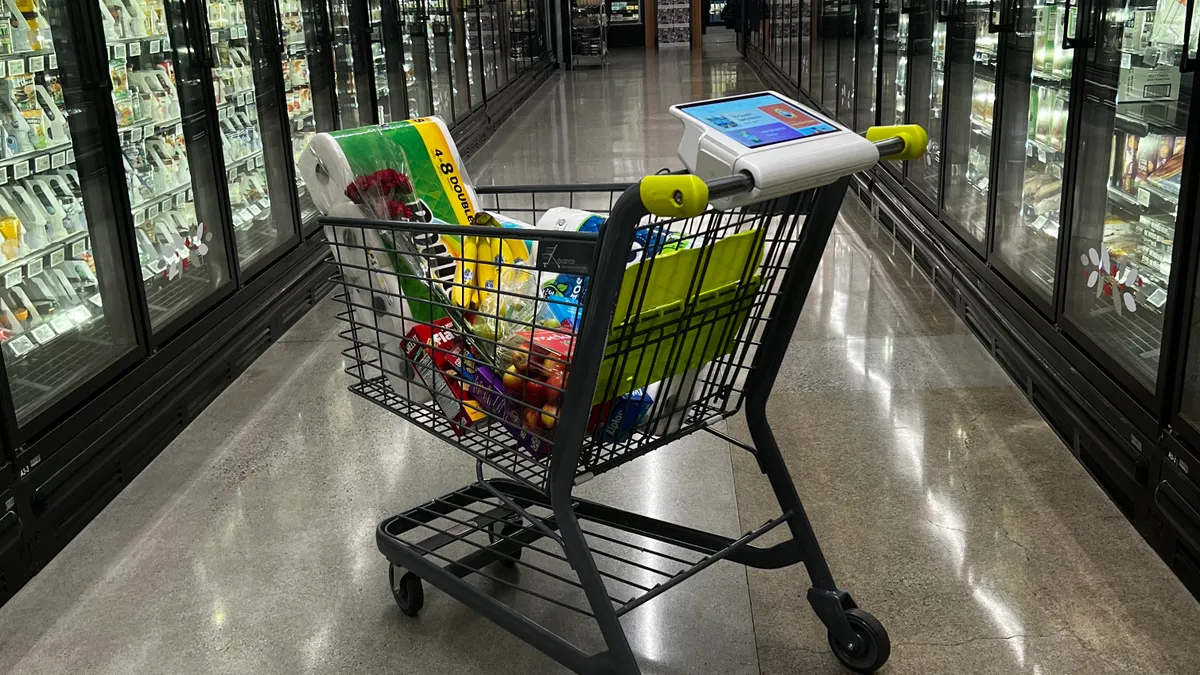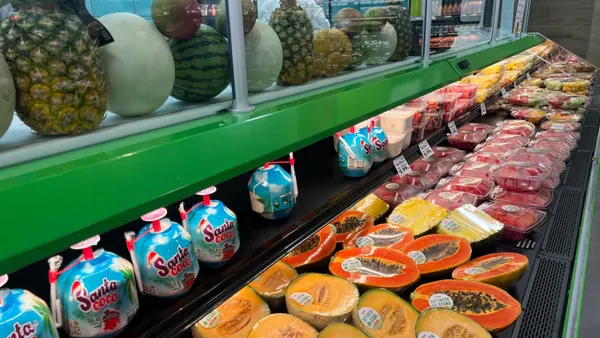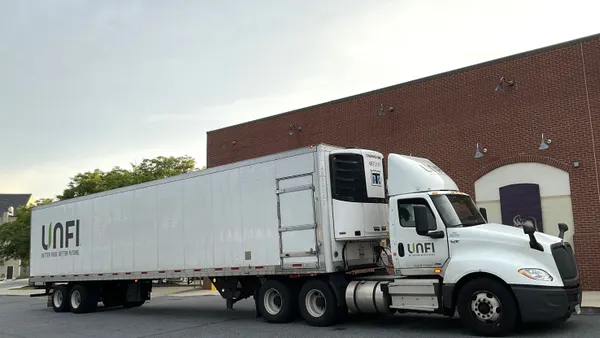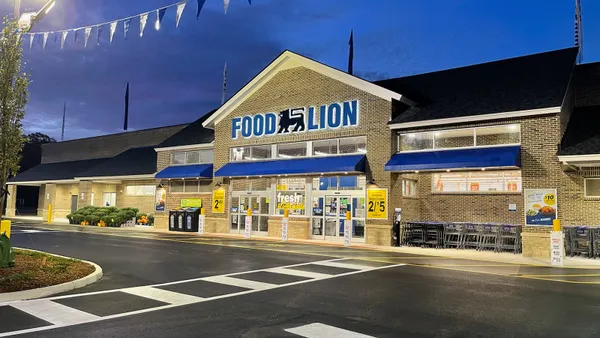After spending its first few years of operations focused squarely on helping retailers speed up the checkout process, smartcart startup Veeve is rolling in a new direction.
The Seattle-based company has developed a new version of its computer vision-based technology designed to serve primarily as an extension of the retail media networks that retailers have been rapidly building, having concluded that the cost of deploying smart carts as checkout-oriented devices can be difficult for grocers to justify, said CEO Shariq Siddiqui.
“The name of the game right now for us is retail media, because that’s just so big and so uncharted,” Siddiqui said in an interview. “There are hundreds of startups doing checkout in multiple different ways and form factors, [but] this is a very unique technology that is introducing the retail media network like it has never been introduced before.”
The new, clip-on devices retain the ability to scan purchases as shoppers put them in the cart and accept payments, but include extra cameras to scan the store interior and connect messages they display with what a shopper is seeing in a store at any given time, Siddiqui said.
The units, which Siddiqui said can be attached to a standard shopping cart in a few minutes, can interact with a retailer’s own retail media network or serve information using an app and content management system provided by Veeve.
Retail media has recently taken on a prominent role in the grocery industry, with an increasing number of food retailers entering the space to tap fast-growing interest by CPGs in reaching shoppers through the channel. Spending on retail media exceeded $40 billion in 2022 and is forecast to surpass $60 billion this year, according to eMarketer.
Retailers have also been embracing in-store technology designed to help them present digital messages to shoppers. Kroger, for example, announced last month that it is adding smart displays from Cooler Screens to 500 stores and will operate them in connection with its retail media network.
Veeve has already begun testing its new, retail media-oriented equipment with several U.S. retailers interested in delivering location-based promotions, coupons, product details and other information to shoppers as they walk around stores, according to Siddiqui. Each of the stores has deployed between 10 and 15 of the units, and plans call for each location to receive between 50 and 100 of the devices during the next few months, he said.
The approximately 30-person company, which has raised about $11.5 million from seed investors and is preparing for a Series A round of funding, has also struck deals with retailers in Western Europe and Dubai to pilot the new equipment, Siddiqui said. Veeve hopes to have 1,000 of the new clip-on smart cart units in the field by the end of the third quarter of 2023, he added.
Siddiqui said Veeve has shifted its attention to retail media networks because it has found that most grocery shoppers are comfortable paying for their purchases at self-checkout counters or by passing through traditional checkout lanes.
In addition, the company determined that smart carts are often too costly for retailers to use solely as checkout devices, in part because they don’t generate the labor savings and other efficiencies that could offset the investment they require, he said. By contrast, Veeve’s new equipment offers a clearer financial return because it collects and provides data that can allow retailers to track shopping behavior, much as they would online, according to Siddiqui.
“What we are doing is we’re basically saying that this is a device that will save [retailers] money and generate a revenue stream that they never thought was possible,” he said.
A way to encourage shoppers to put more items in their carts
Veeve’s retooled smart cart strategy is built on the premise that pushing offers for products to shoppers that reflect their path through the store raises the likelihood that they will purchase those goods, according to Siddiqui. People are not required to log in to their loyalty accounts to use the new units, but the devices still generate data about people’s shopping behavior as they traverse aisles, he said.
Veeve is “not doing any specific customer recognition in any way,” Siddiqui added.
One potential roadblock for Veeve rests in consumers’ hands. As grocers update their apps, they’re adding in-store connectivity functions like aisle navigation and digital coupons that shoppers can use while shopping. Some grocers also let shoppers use their phones to scan and pay for items as they shop. As these apps continue to evolve, retailers may see a smart cart as a redundant technology.
Siddiqui said Veeve’s units offer an edge over smartphones because they don’t require shoppers to keep a store’s app open in order to see promotions while they shop, which Siddiqui said most shoppers don’t do. Smart cart screens are also larger than smartphone displays.
The devices have onboard storage, allowing them to function without a constant connection to a Wi-Fi network, Siddiqui added.
Early results suggest that shoppers tend to put at least twice as many items into their carts when they interact with Veeve’s retail media-focused equipment than if they shop using a cart without the gear, Siddiqui said.
Veeve is still offering checkout-focused traditional smart cart technology, but the company expects only about 30% of the gear it deploys to retailers to fall into that category, he said.
The company notes on its website that its existing customers include Albertsons namesake banner and the grocer’s Safeway and Tom Thumb brands, as well as Good Food Holdings’ Metropolitan Market banner and Kroger. Last May, Albertsons said it planned to bring Veeve’s carts to several dozen locations following a test in 2021.
Veeve faces competition in the smart cart space from a range of companies. Those rivals include Instacart-owned Caper Cart, as well as Cust2Mate and Shopic, both of which are based in Israel. In addition, Amazon offers its Dash Cart to shoppers in certain Whole Foods and Amazon Fresh stores.
While Veeve’s new smartcart technology is in its early stages, Siddiqui said he is convinced that retail media, not checkout, represents the future for smart cart technology.
“This is a great way for retailers to jump on the retail media bandwagon. Otherwise they’re leaving that opportunity for the Metas and the Amazons and the Instacarts of the world,” he said. “I think that’s really more powerful than checkout itself — coming from a guy who started a company for checkout.”











